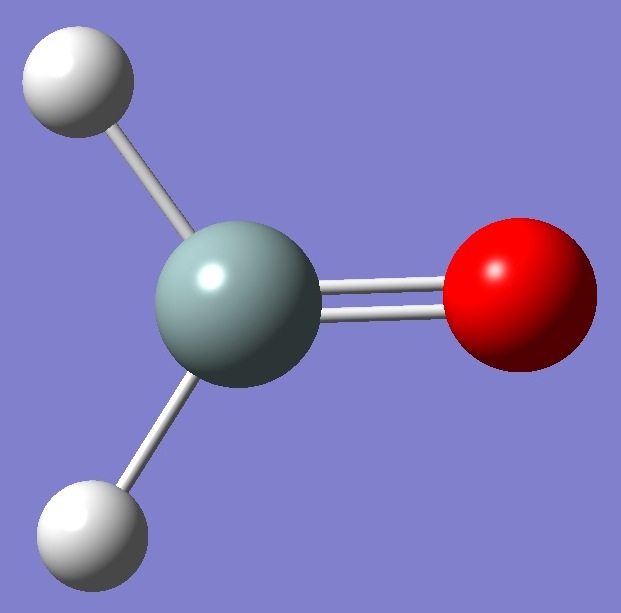|
|
|
|
|
|
|
|
|
|
|
|
|
|
|
|
|
|
|
|
|
H2Si=O |
|
|

|
|
|
|
|
|
|
|
|
|
|
|
|
|
|
|
|
|
|
|
|
|
|
|
|
|
|
|
|
|
|
|
Deuterium |
|
|
|
Nuclear
Quadrupole Coupling Constants |
|
|
|
in Silanone |
|
|
|
|
|
|
|
|
|
|
|
|
|
|
|
|
|
|
|
|
|
|
|
|
|
|
|
|
|
|
|
|
|
Calculation was made here of the deuterium nqcc tensors in silanone on the rmrho structure of Bogey et al. [1]. These are shown in Table 1. |
|
|
|
|
|
|
|
|
|
|
|
|
In Table 1, subscripts a,b,c refer to the principal
axes of the inertia tensor, subscripts x,y,z to the principal
axes of the nqcc tensor. The a-axis is coincident with the twofold
symmetry axis. The nqcc y-axis is chosen coincident with the inertia
c-axis, which is perpendicular to the plane of the molecule. Ø
(degrees) is the angle between its subscripted parameters. ETA = (Xxx
- Xyy)/Xzz. |
|
|
RSD is the calibration
residual standard deviation for the B3LYP/6-31G(df,3p) model for calculation of the nqcc's, which may be taken as an estimate of the uncertainty in the calculated nqcc's. |
|
|
|
|
|
|
|
|
|
|
|
|
|
|
|
|
|
|
|
|
|
|
| |
|
|
|
|
|
|
|
|
Table 1. Deuterium nqcc's
in D2Si=O (kHz). Calculation was made on the rmrho structure [1]. |
|
| |
|
|
|
|
|
|
|
|
|
|
|
Calc. |
|
Expt. |
|
| |
|
|
|
|
|
|
|
|
2H |
Xaa |
|
- 4.0 |
|
|
|
|
|
Xbb |
|
49.9 |
|
|
|
|
|
Xcc |
- |
45.9 |
|
|
|
|
|
Xab |
± |
66.9 |
|
|
|
|
|
|
|
|
|
|
|
|
|
RSD |
|
1.1 (0.9 %) |
|
|
|
|
|
|
|
|
|
|
|
|
|
Xxx |
- |
49.2 |
|
|
|
|
|
Xyy |
- |
45.9 |
|
|
|
|
|
Xzz |
|
95.0 |
|
|
|
|
|
ETA |
- |
0.035 |
|
|
|
|
|
Øz,a |
|
56.0 |
|
|
|
|
|
Øa,SiD |
|
56.0 |
|
|
|
|
|
Øz,SiD |
|
0.0 |
|
|
|
|
|
|
|
|
|
|
|
|
|
|
|
|
|
|
|
|
|
|
|
|
|
|
|
|
|
|
|
|
|
|
Structure parameters, rmrho [1] |
Si=O = 1.515 Å |
|
|
|
|
|
|
SiH = 1.472 Å |
|
|
|
|
|
|
HSH = 112.0o |
|
|
|
|
|
|
|
|
|
|
|
| |
|
|
|
|
|
|
|
|
|
|
[1] M.Bogey, B.Delcroix, A.Walters, and J.-C.Guillemin, J.Mol.Spectrosc. 175,421(1996). |
|
|
|
|
|
|
|
|
|
|
|
|
|
|
|
|
|
|
|
|
|
|
H2O |
H2C=O |
H2C=S |
H2Si=S
|
|
|
|
|
|
|
|
|
|
|
|
|
|
|
|
|
|
|
|
|
|
|
Table of Contents |
|
|
|
|
|
Molecules/Deuterium |
|
|
|
|
|
|
|
|
|
|
|
|
|
|
|
|
|
|
|
|
|
|
|
|
|
|
|
|
|
|
H2SiO.html |
|
|
|
|
|
|
Last
Modified 16 Feb 2009 |
|
|
|
|
|
|
|
|
|
|
